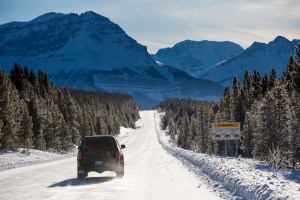
As October and the fall season wind down, it is now time to begin planning for winter adventures in the mountain parks. Winter transforms the Icefields Parkway, one of the world’s most scenic drives.
Ancient glaciers glow winter white under blankets of fresh snow. Quiet descends, broken only by far off sounds of ice crevasses growling as they grow. Snow-covered trails entice drivers to pull over, don snowshoes and break trail below some of the highest mountains in the Canadian Rockies.
Here are a few ways you can connect with great experiences along this iconic drive during the highway's 75th anniversary:
Looking for a quick and scenic stop?
Tangle Falls
Trailhead: 96 km south of Jasper, 137 km north of Lake Louise.
This beautiful cascading icefall right beside the road makes for a great photo stop.
Bow Lake
Trailhead: 193 km south of Jasper, 40 km north of Lake Louise.
One of the most scenic lakes along the Parkway and the source of the Bow River. The stunning views take in the Wapta Icefield, Bow Glacier, Crowfoot Mountain and Mount Thompson.
Crowfoot Glacier
Trailhead: 197 km south of Jasper, 36 km north of Lake Louise.
When this glacier was named a century ago, it looked like a three-toed crows foot. Since then, one toe has melted, and the middle toe is slowly disappearing.
Want to stretch your legs?
Athabasca Falls
Easy: wear sturdy boots.
1 km—30 mins return; no elevation gain/loss.
Trailhead: 30 km south of Jasper, 203 km north of Lake Louise.
Watch the ever-changing ice formations and hear the roar of the water behind the ice. Be safe and stay behind railings and on designated trails, and do not venture out on the ice.
Saskatchewan Crossing Viewpoint
Easy: wear snowshoes or sturdy boots.
200 m—15 mins return; no elevation gain/loss.
Trailhead: 154 km south of Jasper, 79 km north of Lake Louise.
A short stroll to a magnificent view over the North Saskatchewan and Howse river valleys.
Dark Sky Preserve
Are you an avid stargazer or simply enjoy the tranquility and awe of looking up into the night sky? If this sounds appealing to you, you can witness Jasper National Park’s dark sky 365 days a year.
During the month of October, we show our appreciation and celebrate the night sky with dark sky month. This is a great time to visit the park and take in the festivities at the fifth annual Dark Sky Festival from Oct. 16 to 25.
If you can’t make it during that time, Parks Canada still has lots of dark sky programming throughout the month (and year) that showcases this natural treasure. Encompassing over 11,000 km2, Jasper National Park is the second largest dark sky preserve in the world.
Most scenic pull-offs along the Icefields Parkway are plowed in winter, so take a moment to stop, power down, and look up!
These are only a few suggestions for experiencing the Parkway in fall and winter. There is plenty more to do in the mountain parks this winter—check our website or stop in at the Visitor Information Centre to learn more!
Winter driving
Winter can be a magical time on the Icefields Parkway; a wonderland of snow covered slopes, frozen waterfalls and wildlife. With few people, no services, varying road conditions and no cell coverage, however, it is essential to be prepared.
Here are some tips to help you enjoy winter in Jasper National Park and stay safe.
Remember: By law, between Nov. 1 and March 31, vehicles travelling the Icefields Parkway must be equipped with winter tires or tire chains.
Plan Ahead:
Weather in the mountains can be unpredictable and change quickly.
- Always keep a safety kit in your vehicle. This should include water, food, candles, extra clothing and blankets.
- Check the weather forecast and road conditions before you hit the road.
- Let someone know your travel plans.
On the Icefields Parkway during the winter months no road maintenance occurs between 3:30 p.m. and 7:00 a.m.
Be Prepared:
- Speed limits are based on ideal driving conditions - adjust your speed accordingly.
- Road conditions can change quickly. Be sure to consider your winter driving experience, the type and condition of the vehicle you are driving and your familiarity with it as you travel.
- If you encounter a snow plough: follow at a safe distance, pass only on the left and if you pass, be aware that road conditions ahead of the plough may be poor.
Watch For Wildlife:
- Look out for bighorn sheep, mountain goats, coyotes and deer; they are commonly sighted along the Parkway in winter.
- Do not feed or approach wildlife, and stay at least 30 meters from all animals. Pets must be on a leash at all times.
Plan Your Travel, Always Check Ahead:
Visit www.511.alberta.ca, or call 1-855-391-9743 toll-free, or dial 511 (inside Alberta only) for road conditions inside and outside of the mountain parks in Alberta.
Traffic volume and highway conditions outside the park also impact travel times; for BC road conditions, check www.drivebc.ca.
Winter driving conditions in the mountains can be tricky at the best of times but if prepared, there is no excuse not to get out and enjoy this spectacular part of the park.
Parks Canada
Special to the Fitzhugh
